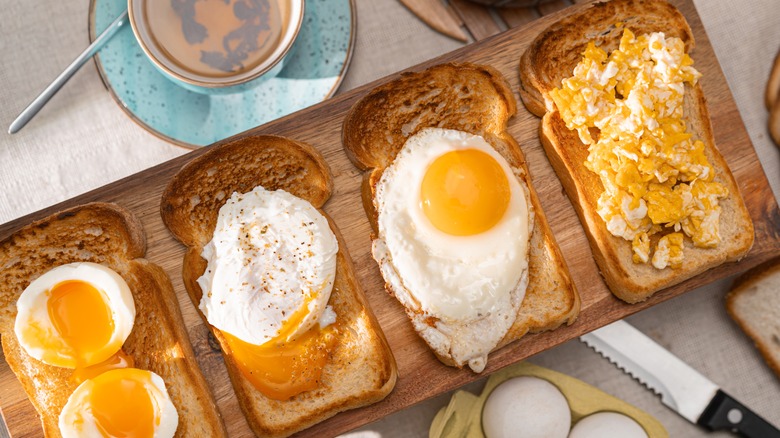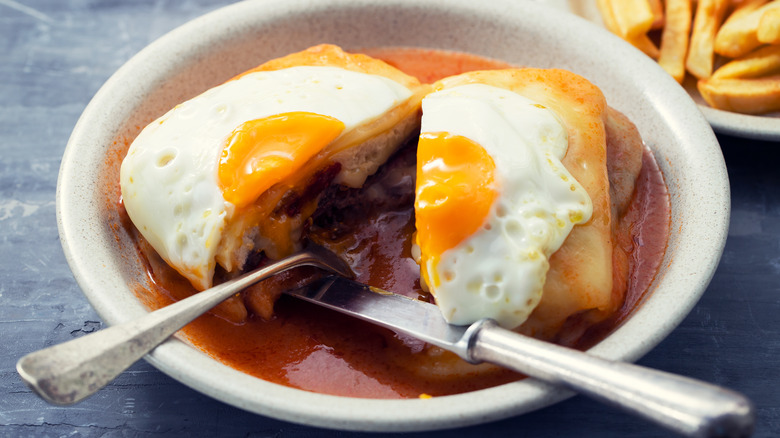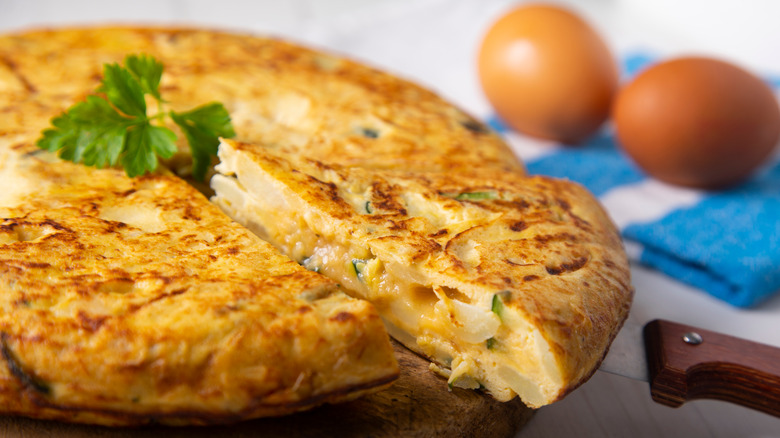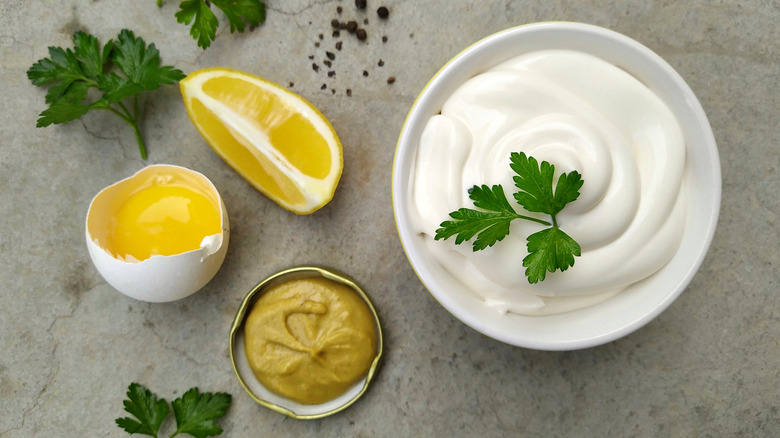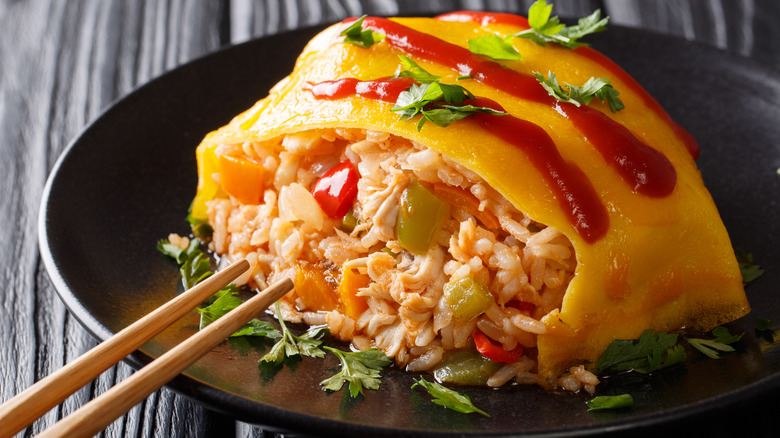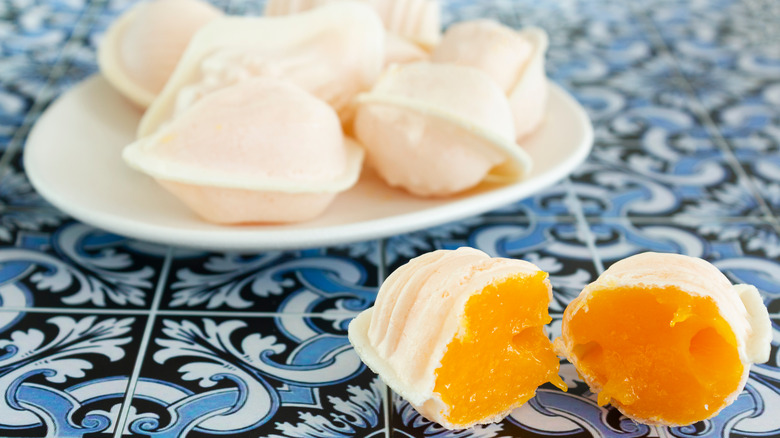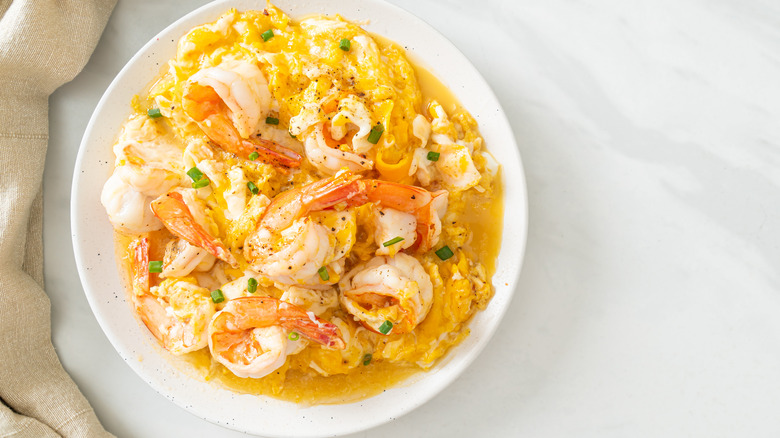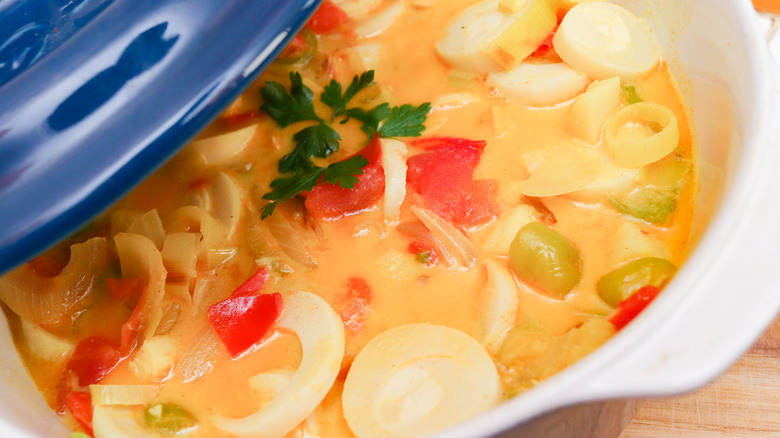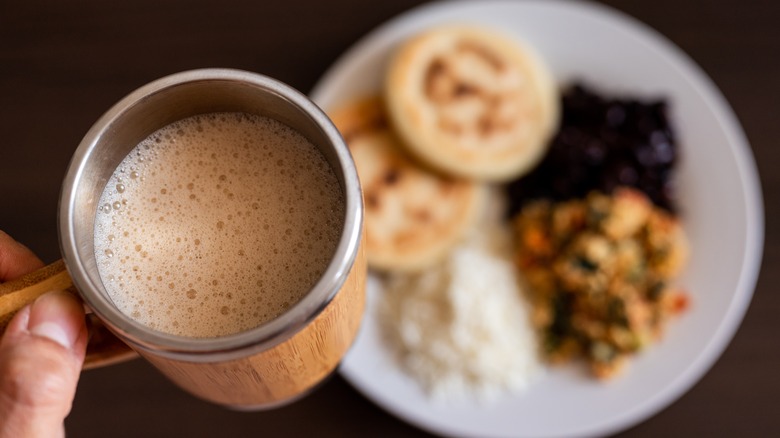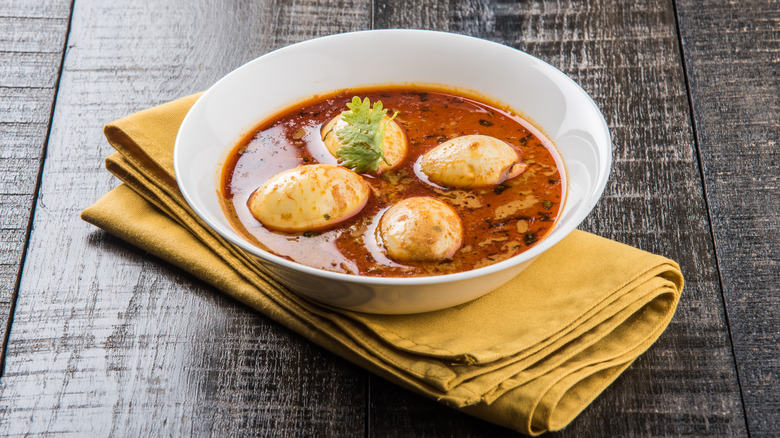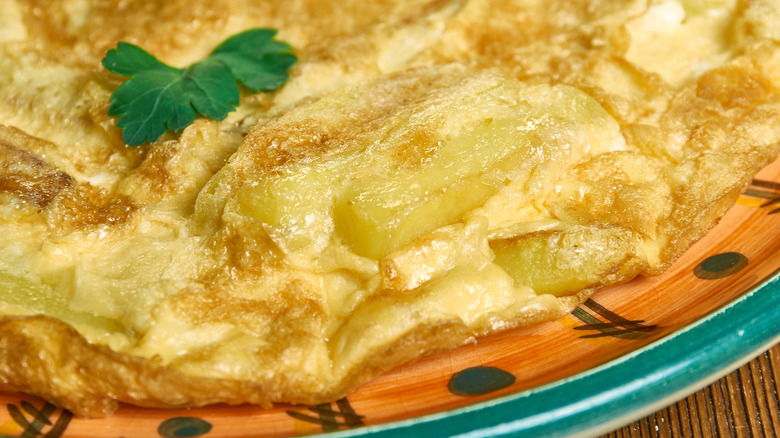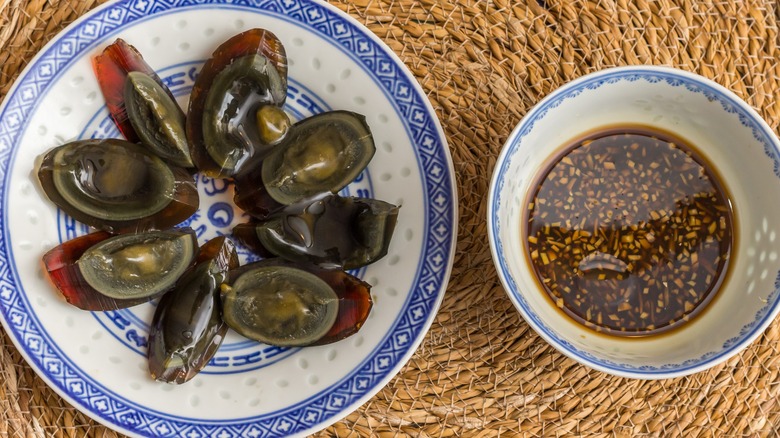12 Ways You Can Make Eggs A Part Of Dinner
Americans love their meat, but a lot of them are looking for ways to cut back. According to a 2021 Ipsos poll, about 89% of Americans consume meat. Nonetheless, per the results of the survey, a sizeable portion of the U.S. population is looking for ways to reduce the amount of meat in their diets. In fact, approximately 18% of women and 10% of men report participating in Meatless Mondays.
While celebrating the occasional Meatless Monday can be fun, it's not always easy to know what to prepare. One way to make sure that you're getting enough protein on those meat-free days is by cooking an egg dinner. According to the American Heart Association, eggs can be an excellent source of protein with about 6 grams per serving. They also contain plenty of helpful vitamins, such as vitamin D, which is good for the bones. Per the AHA, as long as they are consumed in moderation by an otherwise healthy person, eggs can actually be beneficial to your health. And the best part is that there are tons of delicious egg recipes that come from all over the world.
1. Francesinha
There are plenty of healthy egg dinner ideas out there, but the francesinha is definitely not one of them. This outrageously filling sandwich from the Portuguese city of Porto contains two slices of bread, steak, pork, bacon, and sausage (per The Guardian). While that might already seem like a literal tall order, the francesinha's ingredients do not stop there. A layer of cheese is melted on top of the sandwich and a tomato and beer sauce is poured over the whole creation (via Taste Porto). Toward the end of the process, an egg is added to the top of the francesinha, like a crown jewel.
While this meal may sound like a once-in-a-lifetime food splurge, it also holds a fascinating history. The word "francesinha" itself means "little French woman" or "little Frenchie" in Portuguese. The reason for this, according to Taste Porto, is that the francesinha was modeled on the French croque monsieur. During the 1950s and 1960s, many Portuguese workers immigrated to France as they fled the dictatorship of António Salazar, as reported by Rádio França Internacional. When they eventually moved back to their homeland, these former expats brought the croque monsieur back with them. However, in true Portuguese fashion, these migrants weren't afraid to add plenty of extra ingredients to the French classic. And that creative spirit may very well be why no two francesinha recipes are ever exactly the same, as per Porto Secreto.
2. Spanish tortilla
There may be no dish that seems as quintessentially Spanish as the tortilla de patatas. Available all across Spain in locations ranging from bars to taverns to restaurants (per Foodicles), this flavorful dish seems ubiquitous throughout the country that invented it. Nonetheless, the tortilla de patatas is not as purely Spanish as some will claim it to be. As a combination of eggs, potatoes, and oil, it cannot be ignored that one of the tortilla's main ingredients came from the Americas. In fact, in the 1600s, when potatoes first started to appear in European marketplaces, the Spanish weren't sure how to cook them, according to El Plural. It was only after years of trial and error that potatoes slowly became integrated into Spanish cuisine. Now, they are a key ingredient in what is arguably the Spanish national dish.
Tradition may be important, but not every cook wants to preserve it. Over the course of the past several hundred years, the tortilla de patatas has changed tremendously. While some people like to stick to the classic combination of eggs, oil, and potatoes, others like to dress the recipe up a bit. One piece from The Washington Post reveals a version of the tortilla that involves zucchini. Another creative recipe adds raisins, pine nuts, and spinach to the Spanish classic. A particularly cutting-edge Spanish tortilla recipe uses purple potatoes. No matter which version of the tortilla appeals to you the most, this traditional dish makes for a balanced egg dinner.
3. Mayonnaise
Mayonnaise is an egg-based sauce that adds flavor to a number of classic dishes. Using egg yolks, lemon juice, and dry mustard in addition to a whole lot of oil, you can make a delicious homemade mayonnaise recipe that is both silky and flavorful. While this condiment has become increasingly controversial as millennials have taken a step back from it (per Philadelphia Magazine), mayonnaise remains a key part of numerous dishes. By adding a creamy texture to vegetables and fish alike, mayonnaise is still the base for good eats ranging from cold crab dip to zesty coleslaw.
Although the uses for mayonnaise are well-documented, the condiment's origin story is much more complicated. According to Slate, it remains unknown whether mayonnaise was invented in France or in Spain. Per the outlet, the French became aware of the condiment in 1756 when Duke de Richelieu won a battle in Port Mahon, Minorca. To celebrate, the Duke asked his chef to prepare a special meal with cream. The chef agreed, only to find there was no cream on Minorca. According to the Spanish version of the story, the chef asked the locals for an adequate replacement, and the Spanish islanders taught him how to make mayonnaise. In the French version of the story, however, the chef never consulted the locals and instead improvised, inventing the world's first mayonnaise on the spot. Regardless of where it is truly from, mayonnaise makes a delicious addition to an egg dinner.
4. Omurice
If you thought that the omelet was a purely French dish, think again. Omurice is the popular Japanese twist on the French classic. According to the Australian outlet SBS, omurice likely originated around the turn of the century in Japan's Ginza district. As its name suggests, this egg dish combines "omu" (Japanese for "omelet") and "raisu" (Japanese for "rice"). Depending on your preferences, you can also add other ingredients, like chicken, mushrooms, or a demiglace to your creation. One of the most unique omurice recipes also includes soy sauce, cheese, and assorted vegetables. However, if you want to enjoy an age-old take on omurice, add a bit of tomato sauce to the top. As Japanese restaurant owner Kentaro Takayama told SBS, "My mum used to do the tomato sauce-based one, which is more traditional. She'd fold the fried rice into the [omelet] and kinda roll it and add a dollop of tomato sauce on top."
Omurice in and of itself is an innovative dish. It only seems natural that it is constantly evolving. If you are looking to add a new cooking technique to your egg dinner, try making tornado omurice. As per Tokyo Weekender, you can make this creative invention by adding the egg mixture to your pan and grabbing the center with a pair of chopsticks. Then, turn your pan slowly so that the egg takes on the shape of a tornado as it cooks.
5. Ovos moles de Aveiro
Egg yolks, sugar, and water. These three ingredients may not sound like the components of a typical dessert. However, when combined in the right way, these ingredients make one of the most classic Portuguese sweets: ovos moles, or "soft eggs" in English. According to the Portuguese source Oficina do Doce, ovos moles originated in the city of Aveiro in the 1500s. At the time, the nuns from the Convent of Jesus of Aveiro were constantly separating eggs in order to use the egg whites for cleaning purposes. Eventually, they decided to mix the egg yolks with a sugary syrup in order to produce what they hoped would be medicine. Ultimately, though, the nuns' attempt at pharmacology failed, and they instead created a delicious treat.
Over the years, the recipe for ovos moles was passed down from the nuns to certain members of Aveiro's community. And, per Center of Portugal, an investigation into ovos moles by the European Union found that the original recipe is virtually identical to the one used today. This means that ovos moles are one of the only foods that can take you back in time and allow you to experience the same flavors that people enjoyed in Portugal hundreds of years ago. If you are looking for a grand finale for your egg dinner, ovos moles are a truly unique dessert.
6. Huevos revueltos
Scrambled eggs may seem like little more than a boring breakfast buffet staple, but, in reality, this dish is like a nice T-shirt: versatile and easy to dress up. As reported by Jeff Koeler of The Washington Post, the Spanish version of scrambled eggs, known as "huevos revueltos," can be combined with any number of delicious ingredients. One particular favorite includes some combination of wild mushrooms, asparagus, garlic shoots, and prawns. Other versions of the dish could include different types of vegetables, cheeses, and even varieties of cured ham.
While adding some new ingredients to your scramble is important for success, it isn't the only key to making your scrambled eggs into a delicious egg dinner. Part of what separates a scramble from a revuelto is the way that you prepare the eggs. Koeler explains that whisking the eggs, as opposed to scrambling them, can give them a lighter texture. He also recommends gently turning the eggs with the assistance of a wooden spoon. And, according to Ari Weinzweig of The Atlantic, huevos revueltos involve larger quantities of extra ingredients (like mushrooms or prawns) than most Americans are used to. As you add more of these ingredients to your scramble, the less your meal will seem like some version of breakfast. With the right technique and a generous proportion of toppings, your huevos revueltos will become a satisfying egg dinner.
7. Kugel
Kugel is a surprisingly flexible dish that can be served for breakfast, lunch, dinner, or even dessert. According to My Jewish Learning, the reason for this plate's versatility could have something to do with its complicated history. Noodle kugel, as we know it today, was invented by the Ashkenazi Jewish people in the 1500s, around the same time that traders brought pasta from Italy to Eastern Europe. The dish started out as a savory food, combining eggs with egg noodles as well as salt and pepper. However, in the 19th century, more and more Polish Jews got involved in the sugar beet industry, making sugar more affordable and widely available. Consequently, dessert kugel recipes came onto the scene, combining eggs, egg noodles, cinnamon, sugar, and even fresh fruits.
These days, there are plenty of recipes that add a new twist to this centuries-old recipe. If you are making a savory version of kugel, TastingTable suggests substituting potatoes for the noodles. This clever switch is also great for people with dietary restrictions, as it offers a gluten-free take on this classic Jewish egg dinner. Per the outlet, other fantastic allergy-friendly ideas include substituting gluten-free rice noodles for egg noodles and switching cottage cheese out for a nice dairy-free cashew blend.
8. Moqueca
Moqueca is one of the most emblematic contributions of the indigenous Brazilian and Afro-Brazilian communities to the culinary world. According to TastingTable, moqueca is a Brazilian stew that originated in the Northeastern region of the country. There are many different versions of moqueca that could include ingredients such as fish, shellfish, peppers, onions, coconut milk, and palm oil. While the most traditional versions of moqueca mainly consist of seafood, there are other varieties of this dish — such as dried meat moqueca and egg moqueca — that are also fairly typical.
The origins of moqueca are deeply tied to both indigenous Brazilian and Afro-Brazilian cultures. The word "moqueca" itself likely comes from the indigenous Tupi word "pokeka," which referred to a dish consisting of fish wrapped in leaves (per Food'n Road Brasil). Similarly, Brazilian newspaper ES Brasil reports that the method used to cook pokeka was called "moquém." Thus, the dish's linguistic origins and seafood-based ingredients come from the Tupi people. Meanwhile, as Bahia Noite e Dia notes, the addition of peppers and palm oil to the stew was very much an Afro-Brazilian contribution.
9. Perico with arepas
Perico is a delightful specialty from Colombia and Venezuela. According to TastingTable, the dish combines scrambled eggs, onions, tomatoes, and a variety of spices, which could include annatto, ground peppers, and coriander. Although typically eaten at breakfast time, perico can also make a delicious egg dinner with the addition of an arepa.
According to the BBC, arepas were around in Venezuela long before the Spanish arrived. Well before the horrors of colonization, Indigenous Venezuelan people ate small, round bread pieces that were made from corn. The name "arepa" almost certainly comes from the indigenous word for this type of bread, "erepa." While we still do not know exactly how many people ate these "erepas" and in which regions, we do know that the modern arepas can accompany just about any filling. This could be anything from the black beans in Arepas "El Diablo" to the shredded chicken that pairs nicely with this Easy Arepas Recipe. And as TastingTable notes, the combination of a piping hot arepa and some vibrant perico makes for a mouthwatering dinner.
10. Egg curry
Eggs have been something of a controversial subject in India. According to a 2006 survey published in The Hindu, egg consumption in India is very regional, with people in the country's Northern and Western states largely abstaining from eggs and people in the Southern and Eastern states indulging in them. Despite the cultural divide, Indian cuisine is full of delectable egg recipes. One of the most interesting is Kerala-style egg curry, named after the Southern state of the same name.
Kerala-style egg curry consists of hard-boiled eggs cooked in a super hot curry sauce involving quite a few different spices. Some of these spices can include cardamom, coriander, and cinnamon. To give the sauce that extra kick, you can add mustard seeds and green chilies. For folks who are afraid to consume the full Spicy Egg Curry recipe, recipe developer Ting Dalton offers an easy solution. Dalton suggests switching the green chilies out for some supermarket chili powder. Regardless of your individual spice tolerance, however, keep in mind that this egg dinner tastes best if you don't overcook your eggs.
11. Chips mayai
Food does not have to be complicated to taste good. One of the dishes to best prove this point is the popular Tanzanian meal, chips mayai. Chips mayai can use as few as three ingredients: eggs, potatoes, and oil. When combined, these delicious foods make something akin to a french fry omelet. Interestingly, the dish's ingredients are reflected in its name, according to Migrationology. The word "chips" comes from the British term for "fried potatoes," or "french fries," as Americans prefer to say. Meanwhile, the word "mayai" means "eggs" in Kiswahili. In that sense, the name of the food literally means "french fry eggs" and thus remains true to its tasty and simple ingredients.
Although you can make chips mayai with just a few ingredients, there is no harm in adding a few more. If you are hoping to add some veggies to your dinner, do not hesitate to add peppers, onions, or even a special sauce. Kachumbari, a mixture of tomato and onion, is a popular addition to this delightful egg dinner.
12. Century eggs
Chances are that when you crack open a hard-boiled egg, you probably expect to see a smooth, white color. Chinese century eggs, however, don't have a creamy, white interior. According to Cookist, Chinese century eggs are normal duck, quail, or hen eggs that undergo an intense transformation process. The traditional method for making century eggs is quite slow, taking about thirteen weeks. The process begins when the eggs are dunked in a vat full of unusual ingredients: salt, coal, water, and calcium. Then, they are left in the concoction for 100 days. During this time, the eggshell slowly disappears, the egg whites absorb a red color, and the yolk turns olive green. By the end of the process, the century eggs take on a uniquely strong flavor that many foodies consider to be a delicacy.
Although century eggs are world-renowned for their deep flavor, not everyone enjoys them. As reported by the BBC, some people dislike the food due to its intense smell. As Hong Konger CL Chan told the outlet, "I remember my father showing me a century egg, and my first reaction was that it smelled bad. Gradually, I overcame that aversion and started to think of it as this nice thing." Like many foods that require you to develop an acquired taste, century eggs may take an attempt or two to enjoy. Nonetheless, once you've opened your palate, you may just find that century eggs make for a luxurious egg dinner.
